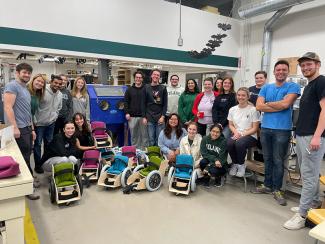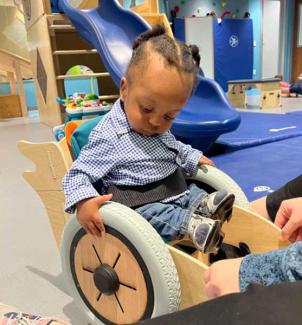Making the wheelchairs involved 3D printing, laser cutting, woodworking, drilling, sewing and assembling, which the team of 30 students did at the Scot Ackerman MakerSpace at Tulane. They added padding and safety straps to the chairs, and they put together baskets of art supplies so the recipients could make the chairs their own.
But before they could even get to that point, they had to do a deep dive into the needs of the children who would ultimately receive the trainers, Raymond said. It’s part of the human-centered design process whereby students cultivate empathy for those who they will be serving.
“Designers need to understand the needs deeply in order to solve them,” she said. “BME students do a great deal of researching, shadowing and interviewing before they even begin to ideate their solutions for medical problems.”
“Lots of our coursework in BME encourages us to prioritize the mental states of patients just as much as their physical states,” said Elana Kraversky, a member of the team who graduated in May and is now working as a device engineer at Pfizer in Chicago. “Knowing that we can make these kids happier, regardless of what they are going through, makes all the difference.”
Assembling the trainers took place over a couple of weekends, under the guidance of Raymond, Platt and Dylan A. Lucia, a visiting instructor who holds bachelor’s and master’s degrees in biomedical engineering from Tulane. He used his expertise in MakerSpace to assist with the assembly and help solve problems. One such challenge was modifying the designs from TOM to fit hardware and wood readily available in the United States. The Tulane School of Architecture also helped.
The team produced a total of 10 mobility trainers. They were donated to Ochsner Health — a partner of MakeGood — for use in pediatric occupational and physical therapy. A new group of biomedical engineering students will take on the project this year, partnering with Ochsner as well as other local health systems.
“The training chairs have been extremely well received by the parents and kids who are clients of Ochsner,” Platt said. “There is a continued demand locally for more of them in the community.
For students, the project was both fun and rewarding, a perfect fit for Tulane’s service-learning requirement.
“One of the strongest aspects of Tulane is its dedication to service,” said Kraversky. “As biomedical engineering students, there is no limit to the opportunities in New Orleans where we can make a difference. This was one of those opportunities.”
‘The design was fairly new, so we had to work through a couple of issues with the assembly, but we were able to work together, and the chairs looked great in the end.” said Anna LeJeune, a biomedical engineering graduate now enrolled in LSU Medical School.
Raymond said it’s humbling for students to see how their work is benefiting children with mobility challenges.
“I can’t help but think that putting in some weekend sweat, creating functional products that are immediately helping kids develop skills for wheelchair use, helps students to see the possibility of the long-term designing, prototyping and testing they are doing in the Team Design course,” she said. “They are ultimately doing all this work to help people with medical needs.”
































































